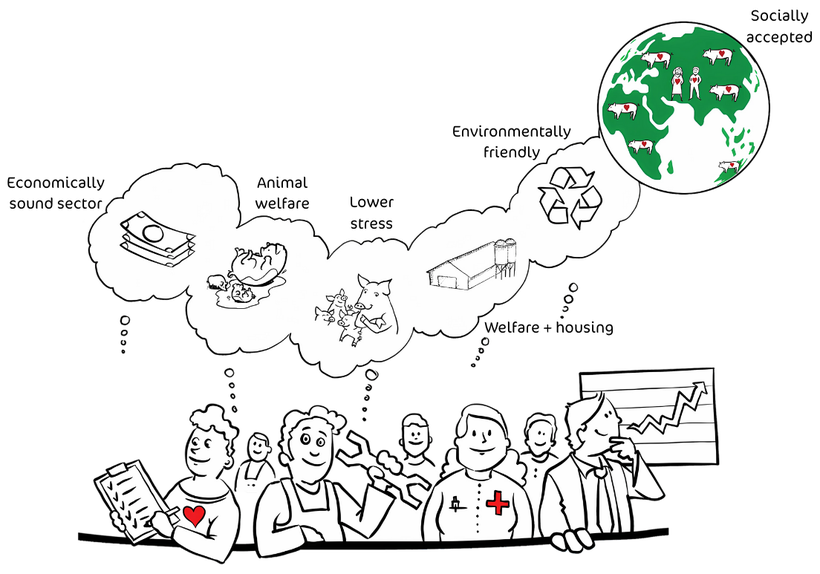
Published on March 28, 2025
Sustainable Swine Breeding: Solutions for a Greener Future
With global meat production increasing consistently through the years, sustainable practices in livestock farming have never been more critical. As population growth and urbanization drive increased demand for pork, we must address the environmental footprint of production.
Hendrix Genetics Swine is at the forefront of this challenge. We combine innovative breeding programs and technological solutions to reduce waste, improve resource efficiency, and support the growing need for environmentally friendly swine production. This approach not only meets society’s demands but also ensures a sustainable future for the global pork industry.
The Importance of Sustainable Swine Breeding
Livestock products account for one-third of the world’s protein consumption. In parallel, we expect global meat production to more than double by 2050, reaching 465 million tons compared to 229 million tons in 2000. Urbanization and population growth are also increasing meat demand. They drive the rapid expansion of intensive livestock farming - particularly pigs and poultry - especially in emerging markets.
However, this growth comes at a cost as the environmental footprint of livestock farming becomes more and more significant. It includes high demands for natural resources and the generation of waste and emissions. To meet global production needs sustainably, we must reduce by half the environmental impact per animal produced. This is where Hendrix Genetics Swine’s technological solutions and innovative breeding programs play a critical role.
The Environmental Challenge: Produce More, Waste Less
To address this challenge, pork producers must focus on increasing production while :
- Reducing Natural Resource Consumption
- Improve feed efficiency to decrease reliance on agricultural land, water, energy consumption, fertilizers, and pesticides.
- Reduce feed consumption while maximizing production output.
- Minimizing Overall Waste
- Alternative manure management, particularly nitrogen and phosphorus, can be an option to prevent the eutrophication of surface water.
- Optimize the use of medications, growth promoters (where applicable), and micronutrients by minimizing excess while ensuring essential levels. Achieve this through precision strategies like targeted feeding, reducing unnecessary metabolites and enhancing efficiency.
- Safely manage livestock losses to minimize waste disposal issues.
Feed Efficiency: A Core Solution
Improving feed efficiency is central to sustainable pork production. Hendrix Genetics Swine’s breeding program optimizes optimizing feed conversion and selecting sows with enhanced productivity and weaning capacity. Therefore, it minimizes feed use while maximizing the number of weaned pigs per sow. This results in :
- Reduced nitrogen and phosphorus waste
- Less NH3 produced and volatilized in the atmosphere
- Lower NO2 (a major greenhouse gas) emissions
- Less phosphorous and lower risk of eutrophication.
- Improved nutrient uptake and digestibility
- Supporting better growth and reducing waste outputs.
Hendrix Genetics Swine conducts continuous research into its animal models, focusing on growth curves, precocity, and Protein Deposition (PDmax). This research ensures that feed formulations are tailored to meet the needs of various physiological stages, especially during growth. By optimizing nutrient uptake, these efforts also help reduce waste and deliver optimal results.
Disease Resilience and Livestock Health
Good animal health is a cornerstone of sustainability. Hendrix Genetics Swine’s commitment to breeding healthier pigs directly translates to reduced organic waste and fewer carcass disposals. Maintaining low mortality and high resilience also reduces the need for antibiotics. It allows us to lower the risk of antibiotic resistance and minimizing harmful metabolites in the effluent.
The Impact of Innovation for an Environmentally Friendly Pork Production
Continuous genetic improvement through classic BLUP Animal Model selection drives ongoing efficiency gains in swine production. However, incorporating cutting-edge technologies like genomic selection significantly accelerates genetic progress.
Hendrix Genetics, our parent company, has for the past years heavily invested in R&D to integrate genomic selection across various breeding programs. These advancements translate into substantial environmental benefits for pork production and all contribute to sustainable farming practices for the medium and long term.
Conclusion
Hendrix Genetics Swine’s breeding program demonstrates a strong link between direct economic aspects and the environmental effects of pork production. We use all available means to both strengthen its competitiveness and its impact on society. By prioritizing environmentally friendly, animal-friendly, and natural production-friendly solutions, Hendrix Genetics Swine ensures a brighter, more sustainable future for the global pork industry.
For more information on Hendrix Genetics Swine’s commitment to sustainable swine breeding and advanced genetic solutions, explore our resources on our economic and environmental pathways.

